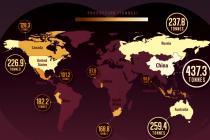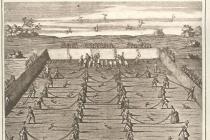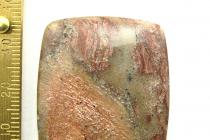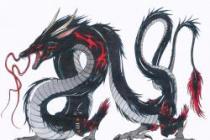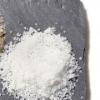Since ancient times, gold has been used for the production of jewelry and coinage. Currently, the role of the precious metal has changed somewhat: coins are no longer made from it, but are used as an investment object and one of the elements of gold and foreign exchange reserves. World reserves of the yellow metal are approximately 55 thousand tons, a significant share of which are gold deposits in Russia.
Gold mining in Russia and the world
Several countries have the largest reserves of the precious metal, including: South Africa, the USA, Canada, Australia, Indonesia and Russia. In the Russian Federation, reserves of the yellow metal are accounted for in 372 primary and 5,000 placer deposits. Every year, approximately 2.5 thousand tons of gold are mined in the world, the bulk of this volume comes from five countries - the USA, South Africa, Australia, Russia and China. Our country ranks 4th-5th in annual gold production with a value of 200 tons.

Gold production by country in tons.
The largest gold deposits in the world include:
- Pebble Deposit - USA, Alaska, no mining;
- Natalka - Russia, Kolyma, no mining;
- Grasberg - Indonesia, production in progress.
Among the top five largest fields there is another Russian one - Olimpiadinskoye (Olympiad), located in the Krasnoyarsk Territory, which has been developed since the early 80s of the 20th century.
All gold reserves in all of Russia are estimated at approximately 12.5 thousand tons of the precious metal, of which more than 60% are industrial reserves belonging to categories A, B and C1 - thoroughly explored, previously explored and reserves of explored deposits of complex geological structure.

In order to imagine how gold deposits are located throughout the territory of our country, we need a map with gold mining areas marked. These areas include:
- Eastern Siberia - Yenisei, Bodaibinsky, Prilensky and East Transbaikal regions;
- Yakutia - Aldan and Verkhoyansk regions;
- Regions of North-East Russia;
- Amur region;
- Territories of Primorsky Krai.
The bulk of Russian gold deposits are located in Siberia and the Far East.
Types of gold deposits
Gold is widely distributed in the surrounding world; the metal is present as a chemical element even in the human body. But in terms of content in the earth’s crust, the precious metal is only in 61st place: its share by mass is less than 0.000001%, the reason for this is its dispersed state in nature.

The largest gold deposits found in the world are places where the yellow metal is found in high concentrations. In these deposits, geological exploration work first takes place, followed by the construction of a mine and the industrial development of existing reserves.
The entire mineral resource base of gold mining consists of direct gold deposits and complex deposits containing gold. Gold deposits are either primary or alluvial.
What is a bedrock deposit?
Primary deposits were formed in the earth's crust due to magmatic processes. In the magma of our planet, in contrast to its crust, the concentration of gold is much higher. For many centuries, as a result of volcanic activity, streams of hot magma burst onto the surface of the Earth. In terms of its content, magma is a melt of a wide variety of compounds. The melting points of these compounds are different, so when the magma cooled, the refractory substances crystallized first. Inside the already frozen mass, the circulation of more fusible elements continued. These processes in the area of magma breakthrough to the surface contributed to the appearance of gold deposits here.

Particles of gold in a primary deposit.
The melt of fusible elements shot out through cracks in the solidified magma, forming veins within which hot solutions of gold-containing salts continued to circulate. When completely cooled, these salts were destroyed, and gold crystallized in its pure form in the resulting veins. During the release and solidification of magma, many chemical reactions took place; the course of this process could differ, as could the final composition of the compounds.
Primary gold deposits could be formed in different ways, but were always accompanied by magmatic processes. This explains the location of the primary deposits: they are always located in the mountains, where the rock was formed as a result of magmatic activity.

Gold in such deposits is very rare in its pure form; most often it contains other metals. The most common alloys are silver and copper. Sometimes there are gold deposits containing platinum and other elements of this group.
Features of placer deposits
Placer deposits are called secondary, the reason for this is the peculiarities of the process of their formation. Placer gold deposits are formed from primary deposits as a result of ongoing physical and chemical impacts. The action of winds, temperature changes, precipitation, the movement of groundwater, the vital activity of microorganisms and plants over a long period of time gradually leads to the destruction of rock. The collapsing rock releases the gold contained in it: the precious metal begins to descend from the mountains into the valley, where a placer-type deposit is formed.

The main factors for the formation of placers are:
- The action of water - it is precipitation and the influence of groundwater that contributes to the destruction of the mountain range and
- Descent of gold-bearing rock down;
- Chemical properties of gold - the metal does not react with water, therefore remains in its original form without changes;
- Physical properties of gold - due to its density, the metal accumulated in those places from where lighter elements were washed out by water.
Alluvial gold deposits are different: they differ in size, territory and method of formation. Changes in the earth's surface occurred over millions of years; often, instead of a primary deposit, a placer deposit could form, and at a very great distance from the initial point of magma release.
Gold in placers is more accessible; in primary deposits it must be extracted from ore. Features of the location of precious metal particles can be clearly seen in the photo of rock fragments from both types of deposits.
Known Russian deposits
The most famous deposits in our country are of the indigenous type, most of them have been developed since Soviet times.
Sukhoi Log
Sukhoi Log is a Russian gold deposit located in Eastern Siberia, namely in the territory belonging to the Bodaibinsky gold-bearing region. Sukhoi Log was discovered in 1961, and today is still one of the largest deposits of the yellow metal in Russia. Large reserves of gold in these places are compensated by its low content in the ore.

After the discovery of the deposit in these places in the 70s, exploration work and technological research were carried out, the purpose of which was measures to enrich the ore. A set of preparatory work was carried out in the next decade. In the 80s, a power line was built here, a year-round road between neighboring settlements, the airport in the nearby town of Bodaibo was reconstructed, and construction of a hydroelectric power station began.

The ores of this gold deposit are of the gold-sulfide-quartz type, the main part of the metal is associated with pyrite. The precious metal content ranges from 0.5 to 10 g/t, the average is 2.7 g/t. Nearby, five more medium-sized deposits with low levels of element content in the ore have been identified. Three fields are already being developed, the rest are still being developed.
Berezovskoe
The Berezovskoye deposit is a unique gold mining site in our country. Its uniqueness is due to the fact that it was discovered back in the 18th century. The discovery is associated with the peasant Erofey Markov. Development at the Berezovskoye field has been ongoing since 1748 and has not stopped to this day.

Nugget from the Berezovsky deposit.
Most of the gold here is small and dusty. Berezovsky is characterized by an uneven distribution of the precious metal: inclusions in sulfides are thin and dispersed in nature. Sometimes the metal is presented in large accumulations in the upper horizons, and even more rarely - in the form of small nuggets.
Since the beginning of work in the 18th century, more than 140 tons of precious metal have been mined here.
The duration of industrial exploitation of the deposit allows us to say that this place has no analogues either in Russia or in the world. Balance reserves of categories C1 and C2 amount to about 90 tons of gold.
Vorontsovskoe
Vorontsovskoye is a famous gold deposit in the Sverdlovsk region. Exploration work here began in the mid-80s of the last century. The development of the gold deposit has been ongoing since the end of 2000. Gold mineralization is represented by two natural types: oxidized ores (loose) and primary gold-sulfide ores.

Vorontsovskoe gold deposit quarry.
The Vorontsovskoe deposit is dominated by free, thin gold in the form of intergrowths with the main minerals of the rock. The size of gold particles varies in the range from the smallest particles to 0.5 mm.
Ore processing is carried out in two ways: oxidized ores are processed by heap leaching, primary ore is processed by the “coal in pulp” method at a metal recovery plant near the deposit.
The Vorontsovskoye field is the first in Russia where heap leaching technology was tested in winter. The positive results of the work carried out made it possible to mine the precious metal all year round, regardless of seasonal conditions.
Creating artificial islands or destroying natural mountains: people are constantly changing the face of the planet. And the miners cope excellently with this task by changing ever larger areas of the landscape. Some pits dug by crushers in an attempt to extract ore are true marvels of technology, and the largest of them are visible from space.
Some of these amazing examples of human ability to subjugate nature are created in the form of open pits. This mining method is used when resources lie too close to the surface and the soil composition does not allow tunneling. Through the efforts of miners, careers grow until resources are exhausted. After the quarries are depleted, they turn into landfills or artificial lakes, but despite this they continue to amaze the imagination with their scale. We invite you to see the best of the largest quarries in the world.
Diamond tube "Mir"
Owner: Alrosa
Resources: diamonds
Location: Russia, Mirny
Development started in 1957
Currently, it is the second largest man-made crater in the world. This diamond mine is located in Russia, near the city of Mirny. “The World” is so huge that flights are prohibited over it, since the mine workings create a very strong downdraft of air. The quarry, whose development began in 1957, produced up to 10 million carats of diamonds per year until its closure in 2011. "The World" was notorious for its terrible conditions. In winter, the temperature in the quarry drops so much that it freezes engine oil and rubber, and leads to the gradual collapse of the quarry. By the time the mine was closed, the time it took to lift the car from the bottom of the quarry to the surface had reached 2 hours.
Diamond tube "Davik"
Owner: Rio Tinto (60%), Harry Winston Diamond Corporation (40%)
Resources: diamonds
Location: Canada
Development started in 2003
The Diavik diamond pipe is located in Canada and is no less impressive than the Mir, despite the fact that it is significantly smaller than its Russian counterpart. Diavik produces 8 million carats of diamonds per year, and the development of the mine began in 2003. It is most notable for the fact that it is located on the island of Lac De Grace, which allows you to observe amazing metamorphoses: in the summer the quarry is surrounded by crystalline water, and in winter it is shrouded in an icy desert. There is a winter road leading to Diavik - the seasonal road is accessible only two months a year, it stretches along the surface of a frozen lake 375 km north of Yellowknife. The rest of the time, you can only get to Diavik by air.


Bingham Canyon
Owner: Rio Tinto
Resources: copper
Location: Utah, USA
Development started in 1904
Visible from space and also known as Kennecott, the Bingham Canyon copper mine is the deepest mine in the world. The discoverers of the mine were the Mormons - who discovered it in the mid-19th century, at that time the deposit reached 1.2 km deep, 2.5 miles wide and occupied an area of more than 7.7 km 2. Surprisingly, despite the fact that the quarry is being developed since 1904, production at the field is expected to continue until 2030.

Calgory Super Pit
Owner: Kalgoorlie Consolidated Gold Mines
Resources: Gold
Location: Calgory, Australia
Development began in 1989.
The Phemiston Open Pit gold mine is the largest gold mine in the world and is commonly referred to as the Super Pit. The oblong-shaped section is located in western Australia, reaches 3.5 km in length, 1.5 km in width and drops to a depth of more than 320 meters. The Super Pit produces more than 850 thousand ounces of gold per year.

Hal-Rust-Mahoning Quarry
Owner: Hibbing Taconite
Resources: Iron Ore
Location: Minnesota, USA
Development started in 1893
The Mahoning quarry began to be developed as an underground mine, but the iron ore turned out to be too close to the surface and the development had to be carried out using an open pit method. Now the Mahoning quarry reaches 8 km in length, 3.2 km in width and 180 meters in depth. During the development of the field, it was decided to combine several smaller workings into one large quarry. For such a “merger” it was necessary to move the city of Hibbing, located in close proximity to the quarries. Relocating the city took 2 years and $16 million, during which time nearly 200 residential buildings and 20 office buildings were moved. At its peak between World War I and World War II, the mine produced 14 percent of all iron ore produced in the United States. Today, almost 100 years later, the Hibbing Taconite Company still uses Mahoning for mining.

Toquepala
Owner: Southern Copper Corporation
Resources: Copper
Location: Tacna, Peru
Development started in 1960
The Andes are home to several of the world's largest mines. Toquepala reaches 700 meters in depth, and the diameter reaches more than 2.5 km. Looking at the photograph taken by a NASA satellite, you can see the giant rock dumps that have formed artificial mountains along the northern part of the mine.

Diamond pipe "Ekati"
Owner: BHP Billiton
Resources: Diamonds
Location: Northwest Canada
Development started in 1998
Ekati is located 300 km from Yellowknife, and was discovered during the gold rush. Since the project opened in 1985, lands from the Great Lakes to the Arctic Circle have been resold like geological lottery tickets. The scientific discovery that proved that kimberlite pipes are a sign of a diamond deposit made Yekati another Jack later in this lottery.

Kimberley Quarry
Owner: Da Beers
Resources: diamonds
Location: Kimberley, South Africa
Development started in 1871
The name - Giant Hole - is what really lets your imagination run wild. The section, 240 meters deep, is the largest mine in the world where mining was carried out manually. The field was originally owned by the Da Beer brothers, which led to a battle over patent licenses with Hal-Rust-Mahoning.
After 16 years of excavations in extremely harsh conditions, small quarries located in the region came to the decision to create a conglomerate, and unite all workings in one company, Da Beers Consolidated Mines Limited. After lying abandoned for more than 100 years, the mine was turned into a UNESCO World Heritage Site.

Grasberg Quarry
Owner: Freeport-McMoRan
Resources: copper, gold
Location: Papua, Indonesia
Development started in 1990
The Grasberg deposit is the largest gold mine in the world and the third largest copper mine. Grasberg's turbulent past includes dozens of expeditions, a rebel attack and $55 million in over-budget construction.
In the 1930s, a Dutch scientific expedition set out to explore one of the highest peaks in the Dutch East Indies. The expedition report reported the discovery of reserves of gold and copper, which later became the Ertsberg Quarry. Due to inaccessibility - the field is located in a mountain range at an altitude of more than 4,100 meters above sea level - construction costs were estimated at $175 million; the project involved the construction of 116 km of roads, an airstrip, a power plant and a port. In 1977, a group of rebels attacked the mine and caused sabotage by planting explosives on the railway line.
Ten years after the attack, Freeport concluded that production had been depleted and began exploring the area around the field in hopes of producing smaller associated deposits. The company hit the jackpot at the Grasberg deposit, located 3 km from Ertsberg with maximum copper reserves of $40 billion. In the aerial photographs below you can see what Grasberg looks like now. And although Östberg began to be developed in the 30s and about $175 million was invested in it, it is too small to be visible.

Chuquicamata
Owner: CODELCO
Resources:: copper, gold
Location: Chile
Development started in 1882
If we talk about volumes, you will not find production larger than the Chilean Chuquicamata. Having moved to the state property after the Chilean nationalization of 1970, the workings reached 4.3 km long, 3 km wide and almost 900 meters deep.
For a brief period, Chuquicamata held the largest annual production volume. Prior to its merger with the Escondida quarry in 2002, the quarry operated the largest smelter and largest electrolytic refinery in the world. It is obvious that the area in the mine area was used for many hundreds of centuries; 17 years after the start of work, a “copper man” dating back to 500 BC was discovered in a blocked temporary working.

Escondida
Owner: Minera Escondida
Resources: Copper
Location: Atacama Desert, Chile
Development started in 1990
Escondida produces more copper than any other quarry in the world. In 2007, Minera Escondida produced more than 1.5 million tons of copper worth more than $20 billion. Construction of the quarry began after studies showed a high probability of the existence of a copper belt in the region, just 300 km from the Chuquicamato quarry.

Berkeley Pete
Owner: Atlantic Richfield Company
Resources: copper, silver, gold
Location: Montana, USA
Development started in 1955
The development of the mine was stopped 30 years ago. Since then, without water pumps to keep the quarry open, the 540-meter pit has filled with rainwater. Despite the fact that the water appears crystal clear from above, in fact it contains a real soup of heavy metals and dangerous chemical elements - such as arsenic, sulfuric acid and cadmium. In fact, the water in the quarry is so rich in minerals that Montana Resources extracts 180 thousand tons of copper per month pumping water into the surrounding ponds.
The mine opened in 1955, production was in the region of 1 billion tons of resource and subsequently grew so much that the owner of the Anaconda deposit bought a neighboring city to continue expansion.

Yuba Goldfields
Owner: Western Aggregate
Resources: Aggregated
Location: California, USA.
Development started in 1848
Yuba Goldfrieds is located along the Yuba River in California. The deposit was established during the gold rush of 1848-55. Being located in the river bed, the mine was in its infancy, but as soon as word spread about the prospects of the region, large mining companies began to actively invest in projects in the region. To minimize production, companies began opening mines using the pressure of water jets in the foothills of the Sierra Nevada. Soon, so much waste and debris was dumped into the river that the river bed rose 100 feet and in some areas destroyed and flooded communities in the river area.
The area has now exhausted its gold reserves and although it is still used for the extraction of concrete components, there are plans to turn it into a nature reserve. Yuba Goldfrieds are known for their unusual appearance, when looking at aerial photography you can see how mountains, streams, and pits created under the influence of many years of mining - like a gut, stretch along the riverbed.

Diamond pipe “Udachnaya”
Owner: ALROSA
Resources: Diamonds
Location: Republic of Sakha, Russia
Development started in 1988
The depth of Udachnaya reaches more than 600 meters, although it is not as wide as Mir. Discovered a little later than Mir, Udachnaya is so remote from civilization that the project had its own small town built for the mine workers, named after the deposit. Since 2010, Alrosa has changed the type of mining at the mine to underground, since open-pit mining has become no longer profitable.

Olympic Dam
Owner: BHP Billiton
Resources: copper, gold, silver, uranium
Location: South Australia
Development started in 1988.
Although BHP Billiton's underground mine has plans to expand into the world's largest open pit mine, it already stretches a long way from what was once Roxby Downs Ships station. Imagine that this deposit contains tons of copper, uranium, gold and silver.
Olympic Dam has the world's fourth largest copper reserve and is the world's largest uranium deposit. Even without expanding the area of the Olympic Dam quarry, it consumes 35 million liters of water daily.

One of the blog readers talked about where and how you can look at real natural gold. The easiest option is to go to one of the quarries that produces a sand and gravel mixture. These small grains of gold were mined from a sand and gravel quarry.
Some will say this is nonsense. This may be true if we look at it on a global scale. Let's look at the grains against the background of a ruler with millimeter divisions.


They already look like a bunch. It seems like something already exists. The true sizes of the grains are in the following photo.

Unfortunately, there is a lot of sand in the alluvial deposits of the Moscow region, and as we know, the density of gold is higher than the density of sand, and grains of metal fall through the sand without accumulating. When examining the sides, it is necessary to find interlayers with a high content of gravel and an admixture of clay. Samples must be taken from different places and one bucket is enough. The task is to wash the sample to black concentrate and not wash away the gold. The washing technique in itself is not complicated, but like any business it requires repeating the same movement many times and only then will the skill and ability come. In order to preserve and process in more comfortable conditions, rinse the black concentrate into a jar.
This is what black concentrate looks like on a regular dustpan.

There are different technologies, but one of the options that makes further work easier is to use a magnet to remove what is magnetized. First place the magnet in a bag or plastic container and then just remove the magnet and the metal will sprinkle on the outside of the protection. Otherwise, it is very tedious to remove magnetic grains from a magnet.
After some time, traces of gold are already visible on the scoop.

This morning we continued the conversation about gold mining in the Moscow region. The probable locations of alluvial deposits were discussed. One of the districts as an example.

The map is heavy, so we discussed a small area. I have maps of the Moscow region. As you can see, the scale is 1:200,000. I’ll help you figure it out. There are also sections and explanatory notes. Those who are interested, write your area and email, as well as your preferred walking places.
After some time, the interlocutor writes that he will walk to the quarry and take a sample, in order to show, using the example of a specific site, where and how samples should be taken and what can come of it.
Here is a photo report of his departure. The road to the quarry.

The quarry itself for the extraction of ASG.

Well, travel lovers are no strangers to trash. Once, one and a half kilometers from the places where I saw the last traces of a person, I found the remains of a washing machine. A broken washing machine with a stainless steel drum. There were finds of unfinished toilets. I'm not talking about cans, bottles and bags; this trash is everywhere.

This is the side of the quarry where samples should be taken.

As we approach the outcrop, we see layers. This is a former river carrying sand and gavia with grains of metal.

Perhaps someone thought that the samples were taken during the performance of some kind of ritual or in the presence of a brass band. You are wrong. Everything is trivial to the point of disgrace. Garbage bin and crowbar. No romance.

All that remains is to wait for the results of the washing. I will let you know as soon as the results become known.
The reader kindly provided material on further sample washing. And let me remind you once again that when testing, you need to take the soil as you have it in order to understand how many tons need to be shoveled for a decent exhaust. This is followed by dividing the 12.5 kg sample into fractions, resulting in 9.5 kg of gravel and 2.5 kg of sand.

The gravel also contains metal, but it must be passed through a mill, but at this stage there is no point in doing this, although there may be a sufficient amount of it. Grains of gold, having a density higher than sand, lie under the sand at the bottom of the basin.

And on the surface flakes of hydromica shine, which sometimes mislead people.

By washing the sand, we obtain a concentrate in which heavy metals predominate. Here is the result of washing a bucket of gravel - 50 g. concentrate. Somewhere in this concentrate there may be grains of gold.

Finishing the concentrate is the most crucial moment. Once you start fine-tuning, don’t stop. Under no circumstances should the concentrate be allowed to dry out. Once dried, gold flakes can become buoyant and float away with the water, so during finishing, do not allow the concentrate and finishing surface to dry out. The finishing surface can be made from a regular garbage scoop. The surface must be sanded to remove the gloss. The surface should not have greasy stains or traces of oil, and be well moistened with water. This is how you can start fine-tuning at home.
Published: August 22, 2012 at 11:55
“Creating artificial islands or destroying natural mountains: people are constantly changing the face of the planet. And the miners cope excellently with this task by changing ever larger areas of the landscape. Some of the pits dug by crushers in an attempt to extract ore are true marvels of technology, and the largest of them are visible from space,” writes samsebeskazal .
Some of these amazing examples of human ability to subjugate nature are created in the form of open pits. This mining method is used when resources lie too close to the surface and the soil composition does not allow tunneling. Through the efforts of miners, careers grow until resources are exhausted. After the quarries are depleted, they turn into landfills or artificial lakes, but despite this they continue to amaze the imagination with their scale. We invite you to see the best of the largest quarries in the world.
Diamond tube "Mir"
Owner: Alrosa
Resources: diamonds
Location: Russia, Mirny
Development started in 1957
Currently, it is the second largest man-made crater in the world. This diamond mine is located in Russia, near the city of Mirny. “The World” is so huge that flights are prohibited over it, since the mine workings create a very strong downdraft of air. The quarry, whose development began in 1957, produced up to 10 million carats of diamonds per year until its closure in 2011. "The World" was notorious for its terrible conditions. In winter, the temperature in the quarry drops so much that it freezes engine oil and rubber, and leads to the gradual collapse of the quarry. By the time the mine was closed, the time it took to lift the car from the bottom of the quarry to the surface had reached 2 hours.
2. Diavik diamond tube
owner: Rio Tinto (60%), Harry Winston Diamond Corporation (40%)
Resources: diamonds
Location: Canada
Development started in 2003
The Diavik diamond pipe is located in Canada and is no less impressive than the Mir, despite the fact that it is significantly smaller than its Russian counterpart. Diavik produces 8 million carats of diamonds per year, and the development of the mine began in 2003. It is most notable for the fact that it is located on the island of Lac De Grace, which allows you to observe amazing metamorphoses: in the summer the quarry is surrounded by crystalline water, and in winter it is shrouded in an icy desert. There is a winter road leading to Diavik - the seasonal road is accessible only two months a year, it stretches along the surface of a frozen lake 375 km north of Yellowknife. The rest of the time, you can only get to Diavik by air. 
3. 
4. Bingham Canyon
Owner: Rio Tinto
Resources: copper
Location: Utah, USA
Development started in 1904
Visible from space and also known as Kennecott, the Bingham Canyon copper mine is the deepest mine in the world. The discoverers of the mine were the Mormons - who discovered it in the mid-19th century, at that time the deposit reached 1.2 km deep, 2.5 miles wide and occupied an area of more than 7.7 km 2. Surprisingly, despite the fact that the quarry is being developed since 1904, production at the field is expected to continue until 2030.

5. Calgory Super Pit
Owner: Kalgoorlie Consolidated Gold Mines
Resources: Gold
Location: Calgory, Australia
Development began in 1989.
The Phemiston Open Pit gold mine is the largest gold mine in the world and is commonly referred to as the Super Pit. The oblong-shaped section is located in western Australia, reaches 3.5 km in length, 1.5 km in width and drops to a depth of more than 320 meters. The Super Pit produces more than 850 thousand ounces of gold per year. 
6. Hal-Rust-Mahoning Quarry
Owner: Hibbing Taconite
Resources: Iron Ore
Location: Minnesota, USA
Development started in 1893
The Mahoning quarry began to be developed as an underground mine, but the iron ore turned out to be too close to the surface and the development had to be carried out using an open pit method. Now the Mahoning quarry reaches 8 km in length, 3.2 km in width and 180 meters in depth. During the development of the field, it was decided to combine several smaller workings into one large quarry. For such a “merger” it was necessary to move the city of Hibbing, located in close proximity to the quarries. Relocating the city took 2 years and $16 million, during which time nearly 200 residential buildings and 20 office buildings were moved. At its peak between World War I and World War II, the mine produced 1/4 of all iron ore produced in the United States. Today, almost 100 years later, the Hibbing Taconite Company still uses Mahoning for mining. 
7. Tokepala
Owner: Southern Copper Corporation
Resources: Copper
Location: Tacna, Peru
Development started in 1960
The Andes are home to several of the world's largest mines. Toquepala reaches 700 meters in depth, and the diameter reaches more than 2.5 km. Looking at the photograph taken by a NASA satellite, you can see the giant rock dumps that have formed artificial mountains along the northern part of the mine. 
8. Diamond tube “Ekati”
Owner: BHP Billiton
Resources: Diamonds
Location: Northwest Canada
Development started in 1998
Ekati is located 300 km from Yellowknife, and was discovered during the gold rush. Since the project opened in 1985, lands from the Great Lakes to the Arctic Circle have been resold like geological lottery tickets. The scientific discovery that proved that kimberlite pipes are a sign of a diamond deposit made Yekati another Jack later in this lottery. 
9. Kimberly Quarry
Owner: Da Beers
Resources: diamonds
Location: Kimberley, South Africa
Development started in 1871
The name - Giant Hole - is what really lets your imagination run wild. The section, 240 meters deep, is the largest mine in the world where mining was carried out manually. The field was originally owned by the Da Beer brothers, which led to a battle over patent licenses with Hal-Rust-Mahoning.
After 16 years of excavations in extremely harsh conditions, small quarries located in the region came to the decision to create a conglomerate, and unite all workings in one company, Da Beers Consolidated Mines Limited. After lying abandoned for more than 100 years, the mine was turned into a UNESCO World Heritage Site. 
10. Grasberg Quarry
Owner: Freeport-McMoRan
Resources: copper, gold
Location: Papua, Indonesia
Development started in 1990
The Grasberg deposit is the largest gold mine in the world and the third largest copper mine. Grasberg's turbulent past includes dozens of expeditions, a rebel attack and $55 million in over-budget construction.
In the 1930s, a Dutch scientific expedition set out to explore one of the highest peaks in the Dutch East Indies. The expedition report reported the discovery of reserves of gold and copper, which later became the Ertsberg Quarry. Due to inaccessibility - the field is located in a mountain range at an altitude of more than 4100 meters above sea level - construction costs were estimated at $175 million; the project involved the construction of 116 km of roads, an airstrip, a power plant and a port. In 1977, a group of rebels attacked the mine and caused sabotage by planting explosives on the railway line.
Ten years after the attack, Freeport concluded that production had been depleted and began exploring the area around the field in hopes of producing smaller associated deposits. The company hit the jackpot at the Grasberg deposit, located 3 km from Ertsberg with maximum copper reserves of $40 billion. In the aerial photographs below you can see what Grasberg looks like now. And although Östberg began to be developed in the 30s and about 175 million dollars were invested in it, it is too small to be visible. 
11. Chuquicamata
Owner: CODELCO
Resources:: copper, gold
Location: Chile
Development started in 1882
If we talk about volumes, you will not find production larger than the Chilean Chuquicamata. Having moved to the state property after the Chilean nationalization of 1970, the workings reached 4.3 km long, 3 km wide and almost 900 meters deep.
For a brief period, Chuquicamata held the largest annual production volume. Prior to its merger with the Escondida quarry in 2002, the quarry operated the largest smelter and largest electrolytic refinery in the world. It is obvious that the area in the mine area was used for many hundreds of centuries; 17 years after the start of work, a “copper man” dating back to 500 BC was discovered in a blocked temporary working. 
12. Escondida
Owner: Minera Escondida
Resources: Copper
Location: Atacama Desert, Chile
Development started in 1990
Escondida produces more copper than any other quarry in the world. In 2007, Minera Escondida produced more than 1.5 million tons of copper worth more than $20 billion. Construction of the quarry began after studies showed a high probability of the existence of a copper belt in the region, just 300 km from the Chuquicamato quarry. 
13. Berkeley Pete
Owner: Atlantic Richfield Company
Resources: copper, silver, gold
Location: Montana, USA
Development started in 1955
The development of the mine was stopped 30 years ago. Since then, without water pumps to keep the quarry open, the 540-meter pit has filled with rainwater. Despite the fact that the water appears crystal clear from above, in fact it contains a real soup of heavy metals and dangerous chemical elements - such as arsenic, sulfuric acid and cadmium. In fact, the water in the quarry is so rich in minerals that Montana Resources extracts 180 thousand tons of copper per month pumping water into the surrounding ponds.
The mine opened in 1955, production was in the region of 1 billion tons of resource and subsequently grew so much that the owner of the Anaconda deposit bought a neighboring city to continue expansion. 
14. Yuba Goldfields
Owner: Western Aggregate
Resources: Aggregated
Location: California, USA.
Development started in 1848
Yuba Goldfrieds is located along the Yuba River in California. The deposit was established during the gold rush of 1848-55. Being located in the river bed, the mine was in its infancy, but as soon as word spread about the prospects of the region, large mining companies began to actively invest in projects in the region. To minimize production, companies began opening mines using the pressure of water jets in the foothills of the Sierra Nevada. Soon, so much waste and debris was dumped into the river that the river bed rose 100 feet and in some areas destroyed and flooded communities in the river area.
The area has now exhausted its gold reserves and although it is still used for the extraction of concrete components, there are plans to turn it into a nature reserve. Yuba Goldfrieds are known for their unusual appearance, when looking at aerial photography you can see how mountains, streams, and pits created under the influence of many years of mining - like a gut, stretch along the river bed. 
15. Diamond tube “Lucky”
Owner: ALROSA
Resources: Diamonds
Location: Republic of Sakha, Russia
Development started in 1988
The depth of Udachnaya reaches more than 600 meters, although it is not as wide as Mir. Discovered a little later than Mir, Udachnaya is so remote from civilization that the project had its own small town built for the mine workers, named after the deposit. Since 2010, Alrosa has changed the type of mining at the mine to underground, since open-pit mining has become no longer profitable. 
16. Olympic Dam
Owner: BHP Billiton
Resources: copper, gold, silver, uranium
Location: South Australia
Development started in 1988.
Although BHP Billiton's underground mine has plans to expand into the world's largest open pit mine, it already stretches a long way from what was once Roxby Downs Ships station. Imagine that this deposit contains tons of copper, uranium, gold and silver.
Olympic Dam has the world's fourth largest copper reserve and is the world's largest uranium deposit. Even without expanding the area of the Olympic Dam quarry, it consumes 35 million liters of water daily. 


